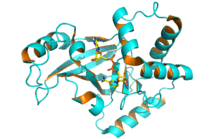Clostridium botulinum C3 toxin
| C3 exoenzyme | |
|---|---|
 Structure of Clostridium botulinum C3 exoenzyme NAD from PDB entry 2C8C [1] | |
| Identifiers | |
| Symbol | C3 |
| SCOP | 2C89 |
| SUPERFAMILY | 2C89 |
Clostridium botulinum C3 exoenzyme is a toxin that causes the addition of one or more ADP-ribose moieties to Rho-like proteins. Many bacterial toxins nucleotide-binding modify by ADP-ribosylation proteins involved in essential cell functions, leading to their toxic effects.[2]
Action
The molecular basis of the action of these enzymes consists in binding of nicotinamide adenine dinucleotide (NAD), splitting NAD into its ADP-ribose and nicotinamide components, and transferring the ADP-ribose moiety to a specific residue on to a protein substrate, often of eukaryotic origin. All the toxins of this family share a highly conserved glutamate, which is the catalytic residue critical for the NAD-glycohydrolase activity. ADP-ribosyltransferase toxins have distinct substrate specificities and variable pathophysiological properties and can be subdivided into four subfamilies: diphtheria-like toxins, cholera-like toxins, binary toxins and C3-like exoenzymes.
C3-like exoenzymes unlike other ADP-ribosyltransferase toxins do not require a specific cell-surface binding translocation component for cell entry. Their specificity is for the small GTP-binding proteins RhoA, RhoB, and RhoC, which are ADP-ribosylated on an asparagine residue.
- ↑ Menetrey, J.; Flatau, G.; Boquet, P.; Menez, A.; Stura, E.A. (March 2008). "Structural basis for the NAD-hydrolysis mechanism and the ARTT-loop plasticity of C3 exoenzymes.". Protein Sci. 17 (5): 878–86. doi:10.1110/ps.073398508. PMC 2327275
 . PMID 18369192.
. PMID 18369192. - ↑ Moss J.; Vaughan M.Russell (1990). ADP-ribosylating Toxins and G Protein, Insights into Signal Transduction. Washington, D. C.: American Society for Microbiology,.